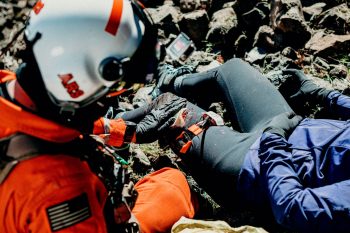Diamond of Death ♦

Carlos Zapa Hernandez
MD, Specialist in critical medicine and intensive care / tactical and operative medicine, Colombia
It is well supported that patients who continue to suffer from shock (or hypoperfusion) are at increased risk of morbidity and mortality attributable to hypothermia, coagulopathy, and acidosis. These three conditions collectively known as the lethal triad, serve as the fundamental physiological insult that describe the mechanisms of action of disseminated intravascular coagulopathy and drive current hemorrhagic shock resuscitation efforts. Hypothermia, defined as a core temperature below 35 ° C, exerts deleterious effects on hemostasis by inhibiting thromboxane-A2, causing a reduction in local vasoconstriction and platelet aggregation at the site of injury, in addition to altering the rate at which the enzymatic process occurs throughout the coagulation cascade.
Furthermore, hypothermia is associated with a leftward shift of the hemoglobin dissociation curve and a reduction in myocardial contractility, leading to reduced oxygenation of tissues and an increased oxygen debt state. These mechanisms described above are directly correlated with coagulopathy and acidosis as irreversible shock progresses through the lethal triad.
Coagulopathy can be further exacerbated by hemodilution of platelets and coagulation factors due to the use of CRISTALOIDS. A review of cases and studies has shown the prevalence of hypocalcemia in trauma and the need to address this deficiency in the treatment of seriously injured patients. From this, it is hoped to promote directed research in the management of hypocalcemia in trauma and to support the recently published guidelines on trauma management that explain this gap in trauma-induced coagulopathy.
We believe that early identification and correction of hypocalcemia in this patient population could be a missing link for the management and prevention of trauma-induced coagulopathy and effectively change the descriptor of the lethal triad to THE LETHAL DIAMOND ♦
Other interesting articles:
Tourniquet myths
“Improvising tourniquets is the best” – Their failure rate is between 80% and 90% although sometimes they are the only option, try not to get there. “Tourniquets are dangerous because…
Read more »Tourniquet
In dangerous or operatively difficult situations, the tourniquet goes high and tight on the clothing, in the lower limb avoids putting it on the iliac crest, it must go under…
Read more »Hemostatic dressing
Packaging of hemorrhages is a critical skill in trauma care where every second and every drop of blood counts. The use of hemostats based on chitosan or kaolin is increasing…
Read more »Hypothermia – The forgotten killer of the trauma patient
Why is it so important? Remember that the diamond of death in trauma is acidosis, coagulopathy, hypocalcemia, and HYPOTHERMIA. These 4 factors will lead our patient to certain death if…
Read more »



